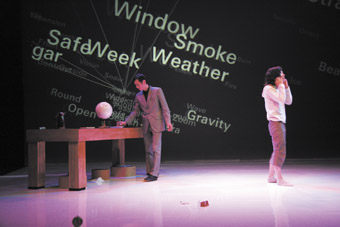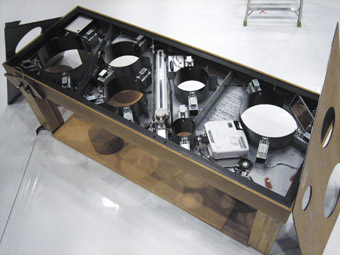the brain-technology dance
matthew gingold: dumb type’s true at isea 2008

Takao Kawaguchi, Tsuyoshi Shirai, True, Dumb Type
photo Yohta Kataoka
Takao Kawaguchi, Tsuyoshi Shirai, True, Dumb Type
A MAN IN A GREY SUIT IS TELLING US ABOUT OUR BRAINS. DESCRIBING THE PERCEPTION OF COLOUR, THE EFFECTS OF CAFFEINE AND NICOTINE AND THE BODY’S REACTION TO SURPRISE, HE SPEAKS IN PRECISE, CLIPPED TONES, DISPASSIONATELY EXPLAINING THE GAP BETWEEN OUR INTERNAL AND EXTERNAL REALITIES. AS HE SPEAKS, HE CIRCLES ANOTHER MAN, WHO IS RE-LIVING THE EXPERIENCES HE DESCRIBES. BEHIND THEM PROJECTED KEY WORDS ARE LINKED WITH MONOCHROMATIC PRECISION, LIKE A DATA-VISUALISATION OF PSYCHO-PHYSIOLOGICAL PHENOMENA. “AS THE ZIGOMATICUS MUSCLES CONTRACT THE MOUTH OPENS HORIZONTALLY”, HE TELLS US, INDIFFERENTLY CONTROLLING THE OTHER’S MOVEMENTS. “AND THE EYES ARE PULLED DOWN TO MAKE A SMILE.” THIS IS DUMB TYPE’S TRUE.
Exploring the “relationship between the brain and the reality we face”, true is an extraordinary collaboration between Yamaguchi Centre for Art and Media, Kanazawa 21st Century Art Museum, Yokohama Red Brick Warehouse and 10 artists from new media, technology, dance and theatre companies, including Dumb Type, rhizomatiks, AbsT/baneto and Softpad. In exploring the interface between reality and the processes that mediate our experience, the makers of true have incorporated as many new media technologies in this production as would seem humanly possible. Their tech rider is staggering.
Though the set is minimal, it becomes apparent during the show that it is deceptively simple. White vinyl covers the floor, and there is a thick wooden table littered with everyday objects. Above, is an 8m wide circular truss of LED lighting especially developed for the show by director and lighting designer Takayuki Fujimoto of Dumb Type. The back wall is a translucent PVC screen, which allows for both front projection and later, a performer to appear, lit from behind. The stage area is sandwiched on both sides by three storey high scaffolds, reminding us that this is a site of construction, where reality is constantly mediated by perception.
The show is divided into nine scenes, reading like the curriculum of some unspecified high school course: Introduction, Science, Music, Physical Education, Verbal Skills, Social Studies, Drafting, Maths and Survival. The Introduction borrows more from silent-movie slapstick than contemporary dance, with Tsuyoshi Shirai (of AbsT/baneto) establishing the naive nature of his character. He seems bewildered, as though awakening, and becomes innocently pre-occupied with the objects on the table—gazing at a picture, bouncing a ball, rearranging a tea cup and kettle. Perfectly synchronized sound effects match Shirai’s manipulation of the objects, some appropriate, and some completely estranged from the motions he makes. Prefiguring the stage craft yet to come, the tea cup moves across the table seemingly of its own volition, and then a large circular section of the table, with tea-cup still atop, drops neatly to the floor.
As we move from the Introduction to Music we meet our second character. Appearing stage-left, clad in a brilliant red PVC hooded robe reminiscent of a boxer’s cloak, this quite ominous character climbs slowly up the scaffold. He observes the action, while occupying the periphery of audience vision. As Shirai executes some bedroom-style air guitar action on the stage below, the red robe is removed and tossed down emulating an MTV video clip.
Unrobed, Dumb Type’s Takao Kawaguchi reveals himself as a stylishly, grey suited character, at once menacing, impish and manipulative. As the relationship between these two characters unfolds, the choreography shifts between formal paradigms, changing from movement-with-intention to contemporary dance through to physical theatre. This relationship begins with one of true’s most breathtaking moments, when the LED lighting executes a dazzling circular strobe, and the dancers spin in opposite directions, their shadows on the white floor appearing to stalk them. Kawaguchi and Shirai continue to perform a series of duets, in which Kawaguchi’s suited character appears to manipulate Shirai’s naive disposition, culminating with Kawaguchi literally controlling Shirai’s face, presenting us with both comedy and pathos, as the face contorts through smile, sadness and scream.
The nature of the relationship between these two characters is ambiguous. Any mention of it is noticeably absent from the program notes, leaving audiences to deduce it for themselves. For me Kawaguchi’s character comes to represent social norms, maturity, expectations and generally the constrictions of the older self, written upon and set in its nature. Shirai represents youth, play, wonder and the promise and possibility of the blank slate. In the wonderfully executed spoken word poetry-dance of Verbal Skills, true speaks of the relationship between the mechanics of perceiving reality and the individual processing of this data into meaning, memory and emotion. In this context Shirai and Kawaguchi perform a kind of coming of age, in which our perceptions and apprehensions shift over time—we are afraid of getting old and then nostalgic for our youth, yet the nature of the stimulus we receive and the way in which we receive it remains unchanged. Why does a colour, a smell or a sound come to mean so much to us?

Dumb Type, true, table mechanics
photo Motoi Ishibashi
Dumb Type, true, table mechanics
True is full of those rare moments when you feel the audience collectively take a breath, when technical wizardry, stage-craft and performance combine to effectively convey emotionally charged imagery. The table and its objects come to life without human touch. The lighting separates and recombines colours, fading and strobing light in a way that traditional theatre lighting simply cannot. Sounds emanate from objects, including the scaffolding, which at one point hums a tune when oscillators vibrate the aluminium structures. The video component, left in reserve until Verbal Skills, is wonderfully simple, and offers surprises, particularly when a tiny projection of a dancing man appears from within the table to light up the spinning globe of an atlas. And all of this is completely synchronous with stage action through the use of myoelectric sensors attached to the performers’ bodies, providing real-time triggers for sound, mechatronics, lights and video. With so much ‘trickery’, true could easily have overplayed its hand, distracting us from the relationship between Shirai and Kawaguchi. Instead the technology serves and enhances the performances in ways rarely seen in new media dance collaborations.
If good contemporary dance goes beyond metaphor, or even aphorism, and provides a series of images for audiences to superimpose possible meanings, then great dance is where those images dive into our desire through all our senses, providing a narrative beyond words, leaving audiences in a state of bodily wonder, alive with altered perceptions. Dumb Type’s true is truly great dance.
International Symposium of Electronic Arts 2008: Dumb Type, true, direction, lighting design Takayuki Fujimoto, choreography, dance Tsuyoshi Shirai, choreography, text, dance Takao Kawaguchi, sound, video, visual design Takuya Minami, sound, oscillation, programming Daito Manabe, video, programming Satoshi Horii, table design, mechanics Seiichi Saito, Motoi Ishibashi, producers Yamaguchi Centre for Arts and Media, 21st Century Museum of Contemporary Art, Kanazawa, Yokohama Red Brick Warehouse, Hi Wood; Esplanade Theatre Studio, Singapore, July 24-26, www.true.gr.jp
RealTime issue #87 Oct-Nov 2008 pg. 5






